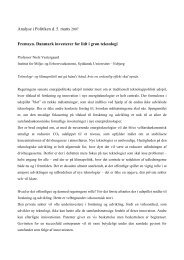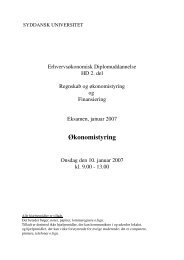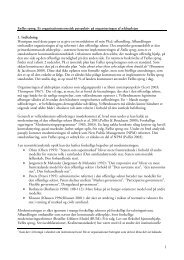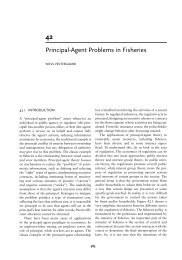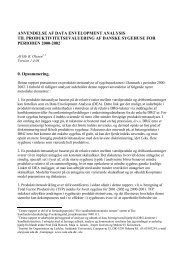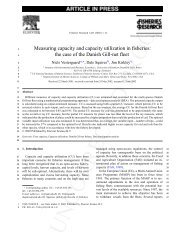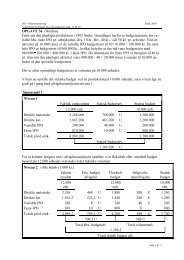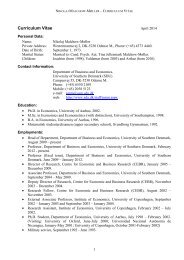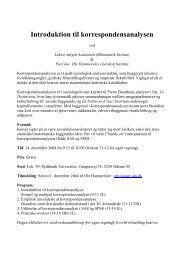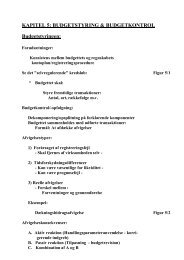w<strong>in</strong>dow <strong>of</strong> opportunity <strong>in</strong> spite <strong>of</strong> some constitutional <strong>and</strong> <strong>in</strong>stitutional limitations, all confirmed atthe first free elections. However, the political capital was more short-term than first expected, <strong>and</strong>for many citis<strong>in</strong>s the new political leaders rim<strong>in</strong>ded about the former communist, at least as far aspolitical style <strong>and</strong> communication was concerned. The new power structures were signified by closepersonal contacts, i.e. several <strong>in</strong>terl<strong>in</strong>ked elite networks. Also the lack <strong>of</strong> political experience amongthe new leaders was strik<strong>in</strong>g. At the same time the majority <strong>of</strong> the electorate preferred discipl<strong>in</strong>ed<strong>and</strong> pr<strong>of</strong>essional politicians, even people with a background <strong>in</strong> the reform-m<strong>in</strong>ded part <strong>of</strong> the oldnomenklatura.Thus the cohesion among former dissidents did not last long. In stead <strong>of</strong> elite consensus <strong>and</strong>cohesion power struggles <strong>and</strong> “wars <strong>in</strong> the top” emerged, br<strong>in</strong>g<strong>in</strong>g democratisation as well asstability <strong>in</strong> danger. The split <strong>and</strong> fragmentation took place at an unfortunate po<strong>in</strong>t <strong>of</strong> time, for underthe prevail<strong>in</strong>g transition anomie <strong>and</strong> <strong>and</strong> economic recession political truce <strong>and</strong> concensus wasbadly needed.Many new parties were lead by a narrow circle <strong>of</strong> ma<strong>in</strong>ly <strong>in</strong>tolerant elites. In other words,censensually united elites soon became dysunified. Overideologization <strong>and</strong> unconstructive political<strong>in</strong>fight<strong>in</strong>g were aimed at accumulation <strong>of</strong> political power. Differences <strong>of</strong> op<strong>in</strong>ion <strong>and</strong> politicaldebate were not considered as a political ressource, but rather as an attack on the nation <strong>and</strong> theunity <strong>of</strong> the party <strong>and</strong> on the party leader himself. Communication failed not only <strong>in</strong>side the parties<strong>and</strong> the political elites fail, but also between the political elites <strong>and</strong> the citizens. 27 Lack <strong>of</strong> contacts<strong>and</strong> responsiveness to the civil societies appeared to be one ma<strong>in</strong> obstacles for further consolidation<strong>of</strong> democracy.Even countries which were considered as the “forerunners”, e.g. the Czech Republic experiencedseveral setbacks. The new elites rema<strong>in</strong>ed too long away from the civil societies, lived too closed<strong>and</strong> ma<strong>in</strong>ly focus<strong>in</strong>g on the work <strong>in</strong> parliament (“overparliamentarization”). The first stage wasmarked by the grow<strong>in</strong>g economic <strong>and</strong> social problems <strong>and</strong> the too big need <strong>of</strong> reforms, <strong>and</strong> thecapture <strong>of</strong> the state apparatus <strong>and</strong> the reckon<strong>in</strong>g with the pas took too many ressources. As aconsequence <strong>of</strong> that the policy <strong>and</strong> programme development <strong>and</strong> the quality <strong>of</strong> the law mak<strong>in</strong>gprocess itself was neglected.The weak l<strong>in</strong>kages to the civil societies had as a consequence a strik<strong>in</strong>g fall <strong>in</strong> politicalparticipation. Because <strong>of</strong> the low <strong>in</strong>stitutionalisation the political parties’ contacts to the electorate<strong>and</strong> party members were modest, mostly mediated through the media. Thus, a party press <strong>and</strong>journal for party members was badly needed. The party life rema<strong>in</strong>ed strongly downgraded <strong>in</strong> them<strong>in</strong>d <strong>of</strong> the elites. Neither between the elections nor dur<strong>in</strong>g the election campaigns the parties werecapable to br<strong>in</strong>g the political messages sufficiently to the voters <strong>and</strong> the party members. In addition,the party c<strong>and</strong>idates <strong>and</strong> even the leaders themselves had not been sufficiently subject to thepolitical tra<strong>in</strong><strong>in</strong>g <strong>and</strong> learn<strong>in</strong>g 28 .Under those circumstances, to improve the quality <strong>of</strong> governance, not only qualified leaders, butalso more competent, politically neutral <strong>and</strong> uncorrupt civil servants was needed. The problems <strong>of</strong>governance were <strong>in</strong>creas<strong>in</strong>g because <strong>of</strong> the low wages <strong>in</strong> the public sector <strong>and</strong> the delay <strong>of</strong>adm<strong>in</strong>istrative reforms. The high elite-circulation was followed by a enhanced politisation <strong>and</strong> close27 See e.g. Jiri Pehe, “Ceske demokraticky system postrada nekretere dimenze”, Hospodarske Nov<strong>in</strong>y 20 January,1998:6.28 See e.g. Mart<strong>in</strong> Potucek, “Ze Sredni Europy na Balkán?”, Ekonom, 1997, Praha:84.36
l<strong>in</strong>ks between the civil servants <strong>and</strong> the new political elites. Several times parties <strong>in</strong> governmentwere accused <strong>of</strong> politication <strong>and</strong> clientelism. In Hungary there was even talk about “italianization”<strong>of</strong> the transformation, due to fragmented party system, corruption, black economy <strong>and</strong> widespreadclientelism <strong>and</strong> well organised mafia-like clientura, i.e. “politcal mach<strong>in</strong>es” rem<strong>in</strong>d<strong>in</strong>g us about theoligarchic system that we f<strong>in</strong>d <strong>in</strong> Russia <strong>and</strong> other CIS countries. Slovakia under the rule <strong>of</strong>Vladimir Meciar has been considered as an illustrative case <strong>of</strong> a clientura based political economicsystem.From 1993-1994, new opportunities emerged for the “modern”, pragmatic <strong>and</strong> accomodat<strong>in</strong>g part <strong>of</strong>the old nomenklatura. Many from that group were recruited from reform-m<strong>in</strong>ded socialist parties,which won the elections <strong>in</strong> countries as Lithuania, Pol<strong>and</strong> <strong>and</strong> Hungary. Many were technocratswho wanted to f<strong>in</strong>ish the modernization project, which they had been able to start but not f<strong>in</strong>ish <strong>in</strong>the 1980’s. Some had been rather young without strong l<strong>in</strong>ks to the top echelons <strong>of</strong> the old statesocialist systems. The political socialization they had obta<strong>in</strong>ed <strong>in</strong> socialist systems <strong>in</strong> decay,work<strong>in</strong>g <strong>in</strong> the “second echelon” until the opportunities for political career arised. Often therelations between those groups were based on elite settlements go<strong>in</strong>g back to the procedures <strong>and</strong>discoursive practices <strong>in</strong> the years lead<strong>in</strong>g to the break through <strong>in</strong> 1988-89. The ma<strong>in</strong> problem for thethe new “post-communist” leaders was the low freedom <strong>of</strong> maneuvre <strong>in</strong> the economic <strong>and</strong> socialpolicy.1.12. <strong>Party</strong> <strong>in</strong>stitutionalizationBy dist<strong>in</strong>guish<strong>in</strong>g between between mass parties <strong>and</strong> cadre parties <strong>and</strong> underl<strong>in</strong>g the impact <strong>of</strong> thecircumstances lead<strong>in</strong>g to the formation <strong>of</strong> parties Maurice Duverger (Duverger, 1954) belonges tothose, who emphasized the significance <strong>of</strong> party <strong>in</strong>stitutionalisation <strong>and</strong> party organisation.Normally it is assumed that changes <strong>in</strong> the relative strength <strong>of</strong> the parties are m<strong>in</strong>or <strong>in</strong> case theparties are <strong>in</strong> possion <strong>of</strong> a relatively strong organisation <strong>and</strong> close bonds exist between the party <strong>and</strong>its voters. Opposite, <strong>in</strong> case the parties are weakly <strong>in</strong>stitutionalised, they may be taken over fromoutside by relatively small elite groups. Due to <strong>in</strong>stitutionalisation the parties are better able tomobilize their corel voters. Close l<strong>in</strong>ks between parties <strong>and</strong> voters foster more party loyalty <strong>and</strong>br<strong>in</strong>g better election results for the parties <strong>in</strong>volved. In some cases the voters even identified theparties by party <strong>in</strong>stitutions. In case the <strong>in</strong>stitutions are strong, the voters are <strong>in</strong> possession <strong>of</strong>structures, to which they are able to make references <strong>and</strong> orient themselvs “ (Mair (ed), 1990-72).From the outset, the historical parties with roots <strong>in</strong> the old system were <strong>in</strong> possession <strong>of</strong> a relativelystrong organisation <strong>and</strong> closer bonds to the voters. However, we must not foreget that many newnon-communist parties achieved a higher party <strong>in</strong>stitutionaliser<strong>in</strong>g <strong>and</strong> better political tra<strong>in</strong><strong>in</strong>g <strong>of</strong>the leaders because <strong>of</strong> a consideral f<strong>in</strong>ancial support from funds <strong>and</strong> sister parties <strong>in</strong> West-Europe<strong>and</strong> US.The subject has been <strong>in</strong>cluded <strong>in</strong> several analysis <strong>of</strong> political parties. The Polish Ewa Nalawejkobelonges to those who at an early po<strong>in</strong>t <strong>of</strong> time underl<strong>in</strong>ed those processes that make an impact onthe party <strong>in</strong>stitutionalisation (Nalewejko, 1997). Special emphasis is laid on the <strong>in</strong>ternal dynamics.Institutionalisation, she argues, roughly speak<strong>in</strong>g <strong>in</strong>volves those processes which that is reflected <strong>in</strong>well known practised <strong>and</strong> recognisable patterns <strong>of</strong> behaviour. Furthermore, <strong>in</strong>stitutionalizationcontrols behavioural patterns supported by formal <strong>and</strong> unformal rules <strong>and</strong> norms. After some timethe patterns <strong>of</strong> behaviour become more <strong>in</strong>ternalised due to <strong>in</strong>creas<strong>in</strong>g bureaucratization <strong>and</strong>rout<strong>in</strong>isation <strong>of</strong> behaviour. Institutionalization gives better opportunities to “produce” <strong>and</strong> re<strong>in</strong>force<strong>and</strong> not only reflect social cleavages. Aleks Szczerbiak (Szczerbiak, 2001) has presented concrete37
- Page 3: “This provisional situation chara
- Page 6 and 7: marketisation and privatisationshor
- Page 8 and 9: purposes, are channels for “expre
- Page 10 and 11: the significance of strategic choic
- Page 12 and 13: presidentialism gave rise to “flo
- Page 14 and 15: antipolitics and reinforcement of a
- Page 16 and 17: In the late 1990’s elections most
- Page 18 and 19: determined primarily by “politica
- Page 20 and 21: politics and antipolitics, all sign
- Page 22 and 23: which attitudes to state regulation
- Page 24 and 25: Anti-communism has been defined in
- Page 26 and 27: elections and the Slovak communists
- Page 28 and 29: Cartel agreementsbetter representat
- Page 30 and 31: Basically the absence of clear cons
- Page 32 and 33: After 1989 different types of polit
- Page 34 and 35: complex project for transition unde
- Page 38 and 39: analyses of party institutionalizat
- Page 40 and 41: political messages and slogans. Thu
- Page 42 and 43: well established party culture may
- Page 44 and 45: expected, much due to the many spli
- Page 46 and 47: Furthermore, the polarisation on el
- Page 48 and 49: Finally, Solidarity can also be con
- Page 50 and 51: whole, on the one side an authorita
- Page 52 and 53: The economic recession and the grav
- Page 54 and 55: election defeat more cooperation an
- Page 56 and 57: The formation of AWS can be conside
- Page 58 and 59: group. RS AWS constituted the Chris
- Page 60 and 61: According to the original plans the
- Page 62 and 63: values. According to Rybicki, as so
- Page 64 and 65: AWS should fight against all types
- Page 66 and 67: 2001 parliamentary election, howeve
- Page 68 and 69: and workers voted ZChN. At the 1993
- Page 70 and 71: The League has been considered as a
- Page 72 and 73: establishment like than LPR’s. Th
- Page 74 and 75: jobs in rural areas, especially sma
- Page 76 and 77: industrial policy. According to the
- Page 78 and 79: pressurizing the government to give
- Page 80 and 81: democrats, thereby locating itself
- Page 82 and 83: To conclude, the Freedom Union (UW)
- Page 84 and 85: Polish middle class. Thus, in Janua
- Page 86 and 87:
such as KSCM and KSS in The Czech R
- Page 88 and 89:
The SLD leaders were mainly recruit
- Page 90 and 91:
the falling popular support for pri
- Page 92 and 93:
innovation was formation of the pol
- Page 94 and 95:
place after talks with each applica
- Page 96 and 97:
Has the Left any freedom of manoeuv
- Page 98 and 99:
medicine, changes in the labour cod
- Page 100 and 101:
The Labour Union (UP), Democratic U
- Page 102:
Nevertheless, before that had taken



